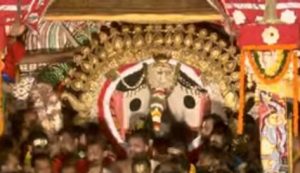Puri: Trinity adorned with 208 kg of gold ornaments for ‘Suna Besha’ on chariots

Puri: Lord Jagannath and His Siblings Lord Balabhadra and Devi Subhadra were adorned with 208 kg gold ornaments during the ‘Suna Besha’ ritual on chariots Sunday, an integral part of the annual Rath Yatra festival in Puri.
The devotees can have ‘darshan’ of the deities from 6.30 pm to 11 pm, said the Shree Jagannath Temple Administration (SJTA).
According to temple sources, the deities adorn around 30 different designs of ornaments which include gold, diamond, silver and other precious metals.
“Initially, around 138 designs of ornaments were used during the era of King Kapilendra Deb in 1460. Around 208 kg of gold ornaments are used in the ritual even today. But, they are not purely gold. The ornaments are made in mixture of gold, silver, precious stones like diamonds and other metals. There has been no separate estimation on gold weight alone in ornaments,” said Bhaskar Mishra, an author and a researcher in Shree Jagannath Culture.
He said the records were available on the use of gold ornaments in Suna Bhesa during East India Company rule in Odisha, but there is no mention of the weight of gold used in the ritual.
The priests associated with the Lord’s Suna Besha claimed that the ornament designs used during King Kapilendra Deb, are also in use today. However, they are repaired sometimes by using the gold donated by pilgrims.
“The gold ornaments are refurbished every year ahead of the Suna Besha on chariots during Rath Yatra,” said Mishra, adding that there is demands to remake certain ornaments as the Lord’s treasury has received around 50 kg of gold from devotees over the years.
Stating that the Suna Besha on chariots is also called ‘Bada Tadhau Besha’ in temple terminology, Prof Surendranath Dash said that the Puri deities adorn golden attire five times a year. However, the ‘Bada Tadhau Besha’ is popular because it is held on chariots and devotees in large numbers get the opportunity to see it. He said this Suna Besha is held on Ashadha Shukla Ekadashi Tithi on the 11th bright fortnight in Asadha.
Four other Suna Besha are held inside the temple on the occasion of Vijaya Dasami (Dasahara), Kartika Purnima, Dola Purnima and Pousa Purnima (Pushyabhiseka) as per Odia almanac.
According to Shree Jagannath culture researcher Asit Mohanty, the ‘Suna Besha’ ritual began in the Puri temple during the reign of King Kapilendra Deb in 1460 when the ruler brought 16 cartloads of gold ornaments to Odisha after winning wars over the rulers in southern India.
The king donated the gold and diamond to Lord Jagannath and instructed the temple priests to prepare ornaments for the ‘Suna Besha’ of the trinity, Mohanty said, adding that the deities are decorated with various types of gold ornaments like gold diadems, locally called ‘Kiriti’, hands and feet made of gold.
Lord Jagannath holds a gold Chakra (disc) in his right hand and a silver conch in his left hand. Lord Balabhadra wields a golden plough in his left hand, and a gold mace in his right hand. Goddess Subhadra also wears different ornaments, Mohanty said.
The specific servitors known as Palia Puspalak, Bhitarchha Mohapatra, Talichha Mohapatra, Daitapatis, Khuntia and Mekap Sevaks decorate the deities with golden attire. Lakhs of devotees irrespective of caste, creed and religion have a chance for darshan of the Suna Besha on the chariots during evening hours of the Ekadashi, Mohanty said.
As Lord Jagannath’s ‘Ratna Bhadar’ is being repaired by the ASI now, the gold ornaments are currently stored in the temporary strong room after valuables were shifted from the outer chamber of the sacred treasury. Escorted by armed policemen and temple officials, ‘Bhandara Mekap’ servitor (store in-charge) bring the gold jewellery laced with invaluable stones and hand it over to Puspalaka and Daitapati servitors for decoration of the deities.
Apart from having a good volume of gold, the Puri temple also owns a vast amount of landed property.
In Odisha, the temple’s land holdings are estimated to be around 60,426 acres across 24 districts. Besides, the temple possesses land in other states, including West Bengal, Maharashtra, Madhya Pradesh, Andhra Pradesh, Chhattisgarh, and Bihar, totalling approximately 395 acres, sources in the Law department said.
PNN & Agencies
News